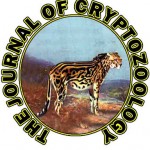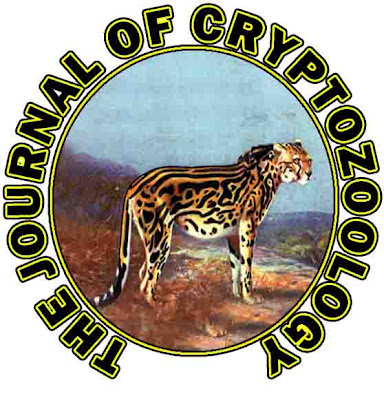
February 29, 2012
Dr Karl P.N. Shuker, the Editor, of the new Journal of Cryptozoology has announced this fresh peer-reviewed publication. Since the journal is planned to be a scientific one devoted to a specific subdiscipline of zoology, i.e. cryptozoology, it must adhere to the same structure and procedures that scientific journals devoted to mainstream subdisciplines of zoology adhere to, which involves submitted papers being assessed by academically-qualified zoologists with specialized knowledge in that particular subdiscipline.

The peer-review panel for the Journal of Cryptozoology is made up of zoologists and other Ph. D.s in associated sciences. They will be asked to evaluate the scientific content and presentation of papers and include:
Tom Gilbert
Colin Groves
Christine Janis
Paul LeBlond
Adrienne Mayor
Darren Naish
Charles Paxton
Brian Regal
Lars Thomas
David Waldron
More doctoral scientists will be added in the future.
Also, a technical peer-review panel has also been established, made up of professionals who will be asked to critique papers on fieldwork, computer skills, photographic expertize, eyewitness interviewing techniques, and sightings evaluation. I will be joining that other peer-review panel.
My congratulations to Jonathan Downes and Karl Shuker. Let the adventures in peer-review cryptozoology begin anew, exactly 30 years after the founding of the ISC’s Cryptozoology in 1982!!

Shuker wrote of the journal recently,
With the demise of Kraken and, in particular, Cryptozoology (published by the now-defunct International Society of Cryptozoology), there has been no peer-reviewed scientific journal devoted to cryptozoology for quite some time. Consequently, the Journal of Cryptozoology is launched today to remedy this situation and fill a notable gap in the literature of cryptids and their investigation. For although some mainstream zoological journals are beginning to show slightly less reluctance than before to publish papers with a cryptozoological theme, it is still by no means an easy task for such papers to gain acceptance, and, as a result, potentially significant, serious contributions to the subject are not receiving the scientific attention that they deserve. Now, however, they have a journal of their own once again, and one that adheres to the same high standards for publication as mainstream zoological periodicals.
To that end, a distinguished peer review panel has been assembled, currently numbering ten members in total* (although this may increase in the future), consisting of some of the world’s most eminent zoologists and associated researchers in their respective fields. And I am honoured to have been invited by the journal’s originator and publisher, CFZ Press, to become Editor – an invitation that I am delighted to accept.
It is planned that each volume of the Journal of Cryptozoology should contain at least four papers. These can be discussion or review articles concerning a given cryptozoological subject, research-related papers, or field reports. Details concerning the required presentation formats for these contributions can be found on the journal’s inside back cover and are also included below.
Down through the decades, cryptozoology has been defined in different ways by different researchers, with some definitions much more restrictive than others. Consequently, it is important to make clear the definition – and therefore the scope of subjects available for papers – to which this journal adheres. For the purposes of relevance to this journal, a cryptid is a creature that is known to the local people sharing its domain (ethnoknown) but unrecognised by scientists. Such a creature may be any of the following:
1) A species or subspecies apparently unknown to science, including alleged prehistoric survivors (e.g. mokele-mbembe).
2) A species or subspecies presently unknown to science in the living state, but which is known to have existed in historical times and allegedly still persists today (e.g. thylacine).
3) A species or subspecies known to science but allegedly existing as a natural occurrence in a location outside its scientifically-recognised current geographical distribution (e.g. puma in the eastern USA).
4) A species or subspecies known to science but allegedly existing as an artificial occurrence (i.e. due to human intervention) in a location outside its scientifically-recognised geographical distribution (e.g. alien big cats in Britain).
5) An unrecognised non-taxonomic variant of a known species or subspecies (e.g. Fujian blue tiger; prior to its scientific recognition, the journal’s logo creature, the king cheetah, was another example from this category).
In addition, papers dealing with fabulous, mythological beasts will be considered for publication in the journal if their subjects have direct relevance to cryptids (e.g. reviewing the similarity between a given lake monster from folklore and cryptids reported in that same lake in modern times).
Some cryptozoological researchers prefer to impose a lower size limit for cryptids, arguing that a crucial aspect of a cryptid’s definition is that it should be of unexpected form. However, as I have revealed time and again in my various books documenting new and rediscovered animals, some very notable, unexpected cryptids were also very small. This is exemplified by Kitti’s hog-nosed bat Craseonycteris thonglongyai, scientifically described in 1974 but already known to the local Thai people, and so dramatically different from all other bats that it required the creation of an entirely new taxonomic family to accommodate it – yet it is no bigger in size than a bumblebee. Consequently, although this journal is primarily interested with ‘classic’ cryptids, i.e. those of large or relatively large size, whose apparent continuing existence undiscovered by science is therefore particularly surprising, papers dealing with interesting, unusual, or potentially significant cryptids of smaller size will also be considered for publication.
Please note: unidentified animal-like (zooform) entities of an apparently paranormal nature, e.g. spectral Black Dogs, fall outside the scope of subjects with which this journal is concerned.
It is always exciting to be part of a major new development, and I believe that the Journal of Cryptozoology marks a major new development in the advancement and mainstream awareness of cryptozoology. I hope that you will too.
About Loren Coleman
Loren Coleman is one of the world’s leading cryptozoologists, some say “the” leading living cryptozoologist. Certainly, he is acknowledged as the current living American researcher and writer who has most popularized cryptozoology in the late 20th and early 21st centuries.
Starting his fieldwork and investigations in 1960, after traveling and trekking extensively in pursuit of cryptozoological mysteries, Coleman began writing to share his experiences in 1969. An honorary member of Ivan T. Sanderson’s Society for the Investigation of the Unexplained in the 1970s, Coleman has been bestowed with similar honorary memberships of the North Idaho College Cryptozoology Club in 1983, and in subsequent years, that of the British Columbia Scientific Cryptozoology Club, CryptoSafari International, and other international organizations. He was also a Life Member and Benefactor of the International Society of Cryptozoology (now-defunct).
Loren Coleman’s daily blog, as a member of the Cryptomundo Team, served as an ongoing avenue of communication for the ever-growing body of cryptozoo news from 2005 through 2013. He returned as an infrequent contributor beginning Halloween week of 2015.
Coleman is the founder in 2003, and current director of the International Cryptozoology Museum in Portland, Maine.
Filed under Breaking News, CryptoZoo News, Cryptozoologists, Cryptozoology, Media Appearances, Men in Cryptozoology, Women in Cryptozoology